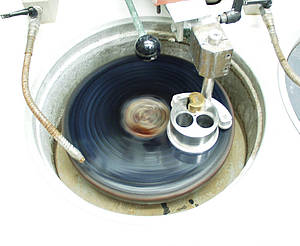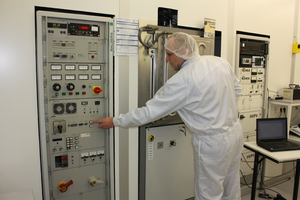Optical Coatings
Dielectric optical coatings provide a means to deliberately tune the reflectivity and transmission of light at an optical interface. Depending on the application obtaining a high transmission or a high reflectivity at certain parts or devices inside a Quantum optical setup are crucial for its success.
Our ability to produce multilayer dielectric stacks allows us to individually adress the specific needs for low insertion losses, high pump rejection and customized filter bandwidths on different materials and optical elements, including waveguide endfaces, fiber tips and bulk optics.
At the heart of our capabilities lies the preparation of waveguide end faces and the dielectric coating fabrication thereon, both being depicted below.
Finishing the waveguide endfaces
In order to allow endfire coupling into our waveguides their endfaces have to be polished perpendicular to the waveguiding channels. To avoid rounding of the endfaces the waveguide sample and a dummy sample are clamped together to provide physical contact between two identical materials. After an equalizing grinding step the endfaces are polished using an alcaline silica sole. The experimental setup for polishing is shown in Fig.1.
Fabrication of dielectric filter coatings
Our guided wave quantum optical devices need specific dielectric filter coatings on the polished waveguide endfaces, e.g. to minimize transmission losses of generated or converted photons and to efficiently block pump radiation. Using a commercial design software we can predict a suitable stack of high- and low index layers to provide a desired characteristics.As our waveguide substrates tend to decompose at elevated temperatures under vacuum conditions, a special coating process has been developed, to allow fabrication of dense, fully oxidized dielectric layers of good adhesion. In a specially equipped box coater we apply ion-assisted reactive e-beam evaporation of SiO2 and TiO2. During this ion-assisted deposition (IAD) the vapour beam and an O2+-beam are superimposed at the substrate surface. The O2+-ions provide an accelerated reoxidization and the necessary migration energy to yield dense layers of good adhesion. This deposition process also takes place in our cleanroom facility as shown in Fig. 2.


